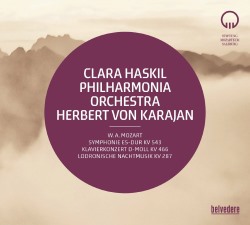
|
Wolfgang Amadeus MOZART (1756-1791)
Symphony No. 39 in E flat major, K.453 [24:48]
Piano Concerto No. 20 in
D minor K.466 [30:39]
Divertimento No 15 in Bb K287 (movs 1 & 4-6) [24:36]
Clara Haskil (piano)
Philharmonia Orchestra/Herbert von Karajan
rec. Mozart Week, 1956, Großer Saal Mozarteum Salzburg
BELVEDERE 10152 [56:06 + 25:02]
Belvedere is a new label emanating from the Mozarteum Foundation. It is releasing material of artistic value from the annual Mozart Week in Salzburg from its beginnings until today. The recordings are marketed as ‘carefully restored sound documents in excellent sound quality’. Their publicity goes on to say that: ‘Concerts from the Mozart Week have been recorded on radio and television since the inauguration of the festival. The treasures in the archives of these concert recordings are now being issued on CD and DVD’.
On 15 May 1955 the Austrian Independence Treaty was signed in Vienna, re-establishing Austria as a sovereign state after the years of Anschluss, war and occupation. This officially came into force on 27 July 1955. Of significance is that a year later on 27 January 1956, Austria celebrated the two-hundredth anniversary of the birth of its greatest musical son, Wolfgang Amadeus Mozart. In order to mark this restored national identity, the annual Mozart Week in Salzburg was founded, and has continued every winter to this day. Perhaps the highlight of the week was the concert of 28 January 1956, the day after the composer’s birthday which featured Herbert von Karajan and Clara Haskil. Karajan had been born in the city, and was returning after several years' absence with the London-based Philharmonia Orchestra, the brainchild of record producer Walter Legge. This was the one and only time that Karajan and Haskil collaborated during a Mozart Week, although they did perform together on several occasions elsewhere. The pianist was to die tragically four years later. The concert garnered rave reviews from the press, with the reviewer of the Demokratisches Volksblatt singling out the strings, woodwind and brass sections for special mention.
The Symphony No. 39 was a work the maestro returned to many times. The performance has great presence. In the stately adagio opening of the first movement, he sets the scene for the allegro by effectively building up the tension. The allegro is rhythmically alert and much more free and less burdensome than some of his later renditions. The second movement is graceful and charming, with Karajan eliciting refinement and poise. The finale is light , brilliant and polished, and I would single out the diaphanous woodwinds for special mention.
Undoubtedly the Karajan/Haskil collaboration will be, for many, the highlight of this release. The pianist’s discography is awash with both commercial and live recordings of Mozart’s Piano Concerto No. 20 in D minor K466. It can be generally agreed that this work, more than any other, was her calling-card. Browsing through my own collection I found six versions with Haskil as soloist. The 1956 performance here has already seen the light of day on a Tahra CD (TAH 628) which I have, and a Memories Reverence 2 CD set (MR2256/7), long since out of print.
The concerto performance with Karajan is an intelligently informed reading of great nobility, taste and refinement. What I have always favoured in Haskil’s Mozart is that she allows the music to speak for itself, without forcibly stamping her own personality on it. She brings out the dark tragic nature of the work, underpinning it with honesty and humanity. To many who had the privilege of witnessing her in concert, there was a certain incongruity between her frail physique, and the wonderful power and technique she achieved. Her success in Mozart was due to her deft fingerwork, pearl-like articulation, elegant phrasing, luminosity and achievement of colour and sonority with judicious use of pedal. Tempi, dynamics and rhythmical fluency all add to the success of the mix.
A cursory re-acquaintance, to refresh my memory, with the versions I hold reveals an interpretive similarity throughout. A 1952 performance with Schmidt-Isserstedt on Tahra (TAH 584/5 and TAH 4025/6) is one of the most satisfying with pianist and conductor intuitively attuned to one another. The Live 1957 from the Montreux Festival with Paul Hindemith (Music and Arts CD 4864) reveals a little untidiness in the pianist’s technique, and the ensemble is a tad rough-edged. I have never been wholly satisfied with the 1960 studio version with Markevitch, finding it rather cold and calculating, and lacking the spontaneous and inspirational spark of the live airings. Also, the piano sound is a little hard. Henry Swoboda and the Winterthur Orchestra on Westminster (471 214) is very fine but the conductor, for some inexplicable reason, ruins the flow of the music in the bars leading up to the first movement cadenza, with an overdone and overblown rit, which sounds totally out of place. The RIAS recording on DG with Fricsay is very persuasive. I have never heard Haskil’s version with Klemperer.
Listening to Belvedere’s K466 side by side with Tahra’s, I prefer the latter’s bolder brighter transfer, which confers more bloom on the orchestral sound. This is especially evident in the woodwinds. It also accentuates the pearl-like sonorities of the piano.
Interestingly, the Divertimento No. 15 in B flat K287 had already been played earlier that day at the matinée concert with Willy Boskovsky’s Wiener Oktett. Karajan chose only four of the six movements for the evening concert. As with the symphony, this was a work the conductor returned to many times over the years. It is a delightful piece, and makes a pleasing listen.
Sound quality is more than acceptable for the age and provenance of the recordings. Excellently presented, with comprehensive annotations in German, English and French, setting the context, this is a highly desirable release. It also marks an auspicious launch of a new label. I look forward to many more treasures emanating from this source.
Stephen Greenbank
 |
 |
|
